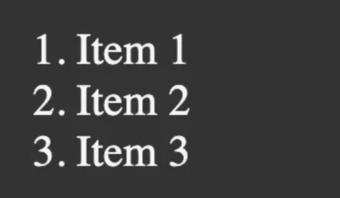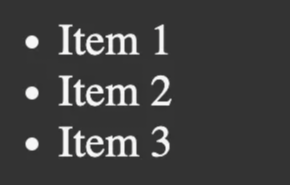Learning HTML Part Deux
I recently decided to start digging into frontend technologies. I started with HTML and poked around a little. This post is picking up where the previous one left off.
Ordered Lists
Ordered lists are numbered lists. Plain and simple. They are opened using the ol element, and each item in the list is enclosed within a li element. The example below is pretty straightforward.
<ol>
<li>Item 1</li>
<li>Item 2</li>
<li>Item 3</li>
</ol>
Which renders like so in a browser:

Unordered Lists
Unordered lists are bulleted lists. They are opened using the ul element, and each item in the list is enclosed within a li element. The example below is also pretty straightforward.
<ul>
<li>Item 1</li>
<li>Item 2</li>
<li>Item 3</li>
</ul>
Which renders like so in a browser:

Description Lists
Description lists are used to present a list of terms and their corresponding descriptions. The dl element is used for the list itself. The dt element creates a description term and then the dd element creates the data description. I honestly am not entirely clear why someone would choose to use a description list but it does seem to be pretty ubiquitous. The code itself is easy to read:
<dl>
<dt>Item 1</dt>
<dd>This is the first item in the description list</dd>
<dt>Item 2</dt>
<dd>This is the second item in the description list</dd>
<dt>Item 3</dt>
<dd>This is the third item in the description list</dd>
</dl>
Which renders in the browser as follows:

Anchor Tags
Anchor tags create hyperlinks and are the way the web is linked together. The anchor tag is just a and uses several attributes in order to control the behavior of the link. The below example shows absolute linking:
<p> The <a href="https://developer.mozilla.org/en-US/">MDN</a>
is a good web resource </p>
What makes this absolute is that the full URL is provided in the link. Relative linking is based on the location from where the current page is in the directory structure. So given this structure:
$ tree .
.
├── about.html
├── html5.png
├── img
│ ├── caribbean.jpg
│ ├── html\_logo\_300x300.png
│ └── vacation.jpg
├── index.html
└── main.css
1 directory, 7 files
The about.html file can be referenced using just the file name in the index.html page:
<a href="about.html">About Me</a>
Wrap Up
Thanks for reading! Next time I’m going to write about how to handle images on web pages.